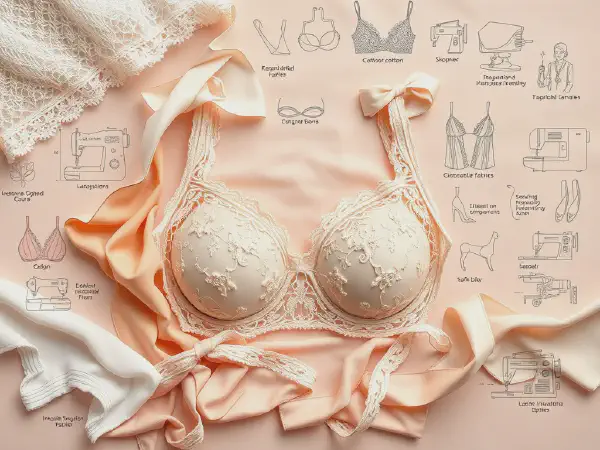Essential Insights on Daisy Bra Materials and Manufacturing

Exploring Daisy Bra Materials and Manufacturing
Daisy Bra Materials and Manufacturing are pivotal aspects of the lingerie industry, combining comfort, style, and sustainability. This article delves into the various materials used in Daisy bras, their manufacturing processes, and how these factors influence the overall quality and appeal of the product.
The selection of materials in Daisy Bra Manufacturing plays a crucial role in determining the comfort, durability, and aesthetic appeal of each piece. With a keen focus on both natural fibers and innovative synthetic materials, Daisy bras aim to cater to a diverse range of consumer preferences and body types.
Sustainability is a key consideration in the Daisy Bra Manufacturing process, with an emphasis on environmentally friendly practices and materials. From sourcing to final production, the commitment to sustainable methods not only benefits the planet but also aligns with the values of modern consumers.
Moreover, ergonomic design considerations are integral to Daisy Bra Manufacturing, as the brand strives to provide the perfect fit for every individual. The blend of comfort and style is further enhanced by the incorporation of the latest fashion trends and technological advancements.
In conclusion, Daisy Bra Materials and Manufacturing represent a harmonious balance of innovation, sustainability, and consumer demands, leading to a product line that is both functional and fashionable.
Materials Used in Daisy Bras
Natural fibers such as cotton, bamboo, and modal are commonly used in Daisy bras due to their breathability, softness, and hypoallergenic properties. These materials not only provide comfort against the skin but also allow for moisture absorption, making them ideal for everyday wear.
Synthetic materials like nylon, polyester, and spandex are also prevalent in the production of Daisy bras. These materials offer durability, stretch, and support, making them excellent choices for constructing bras that need to provide lift and hold without compromising on comfort.
Innovative blends, combining natural and synthetic fibers, are gaining popularity in the design of Daisy bras. This approach ensures that the end product benefits from the strengths of both types of materials, offering a unique combination of comfort, style, and functionality.
Manufacturing Processes for Daisy Bras
Sustainable manufacturing practices are at the forefront of Daisy Bra production. Utilizing eco-friendly materials, reducing waste, and implementing energy-efficient processes are key components of the brand's commitment to sustainability.
Quality control in bra production is meticulous, ensuring that each item meets the high standards expected by consumers. Rigorous testing for durability, fit, and comfort is conducted throughout the manufacturing process to guarantee a consistently superior product.
Technological advances in lingerie manufacturing play a significant role in the production of Daisy bras. The integration of digital printing, automated cutting machines, and advanced stitching techniques enhance both the quality and efficiency of the manufacturing process.
Design Considerations for Daisy Bras
Ergonomics and fit are critical design considerations for Daisy bras, as they are crafted to accommodate a variety of body types. This focus on comfort ensures that wearers can enjoy all-day support without sacrificing style or appearance.
Aesthetic design trends influence the look and feel of Daisy bras, with seasonal collections reflecting current fashion styles. From delicate lace to bold colors and prints, the aesthetic appeal is carefully balanced with function to create products that are fashionable and wearable.
Functional features such as support and lift are essential in the design of Daisy bras. The incorporation of underwire, padding, and contouring techniques ensures that each piece provides the necessary support while maintaining a natural silhouette.
Market Trends in Daisy Bra Materials
Consumer preferences are shifting towards sustainable materials, prompting Daisy bras to prioritize eco-friendly options in their designs. This trend reflects a growing awareness among consumers about the environmental impact of fashion and a desire for responsible purchasing.
The impact of fashion trends on manufacturing practices is significant, with Daisy bras adapting to new styles and consumer demands. Whether it's a rise in loungewear or athleisure, the manufacturing process is agile enough to respond to changing market needs.
Emerging technologies in fabric development, such as moisture-wicking and temperature-regulating materials, are influencing the design and function of Daisy bras. The integration of these technologies enhances the overall wearability and appeal of the products.
Care and Maintenance of Daisy Bras
Proper washing and drying techniques are essential in maintaining the quality of Daisy bras. Hand washing or using a gentle cycle in cold water is recommended, along with air drying to extend the life of the elastic and fabric.
Storage tips, such as laying bras flat or using a dedicated lingerie drawer, help maintain their shape and prevent damage. Avoiding folding them in half keeps the cups intact and prolongs their lifespan.
When it comes to repairing vs. replacing your bra, assessing wear and tear is crucial. Minor damages, like loose threads or a broken clasp, can often be repaired, while significant wear may warrant a replacement to ensure continued support.
Comparative Analysis of Bra Materials
Analyzing Daisy bras against competitors in the market highlights their commitment to quality materials. While many brands may use similar fabrics, Daisy's focus on sustainability and ethical production sets them apart.
Material performance comparisons reveal that Daisy bras effectively balance comfort, durability, and style, often outperforming competitors in customer satisfaction. The use of innovative blends and high-quality fabrics reinforces this advantage.
Lastly, the cost vs. quality in bra materials is a significant consideration for consumers. Daisy bras may be positioned at a higher price point, but the investment in quality, comfort, and sustainability makes them a preferred choice for many shoppers.
